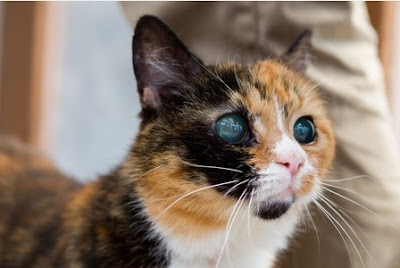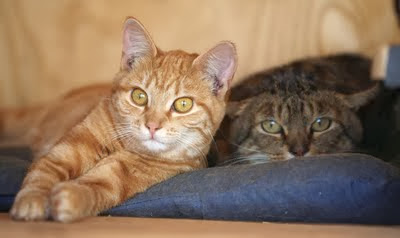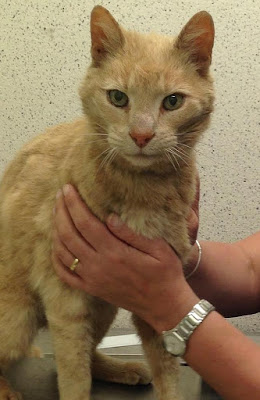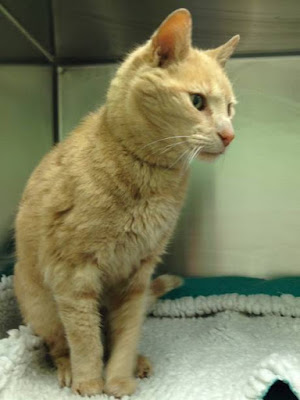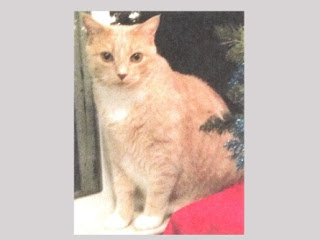 |
| Ollie |
"Hello all my wonderful friends. Sadly I have to tell you that I gained my 'wings' yesterday and I will be carrying out my security patrols and checking for squirrels over the Rainbow Bridge."
-- Ollie's terse obituary as it was announced May 6th on Facebook
The cat world was robbed of one of its brightest and most elegant stars on May 5th when Ollie, the former world famous resident feline of Manchester International Airport (MIA) in Ringway, was deliberately killed off by an unidentified veterinarian acting upon the orders of her present-day guardian. Although her age has not been publicly disclosed, the lovely yellow and white little girl must have been at least ten years old considering that she likely was at least two years old when she first strolled into MIA back in 2007.
In the end it really does not make any difference how old she was in that she had an inalienable right to have lived out her life to the bitter end and then, and only then, to have died a natural death. The precipitate actions of her guardian and the unscrupulous old sawbones who whacked her can therefore only be classified as cold-blooded, premeditated murder!
The news of Ollie's premature demise was announced on the world wide web by an insurance manager identified only by her first name as Jennifer from Northenden, 8.85 kilometers north of Ringway and 8.4 kilometers south of Manchester City, who had served as her caretaker for the past four years. "Hello all my wonderful friends," she, speaking for Ollie, began the May 6th posting on Olly (sic) the Airport Cat's Facebook page. "Sadly I have to tell you that I gained my 'wings' yesterday and I will be carrying out my security patrols and checking for squirrels over the Rainbow Bridge."
As is the case with her age, it is far from clear exactly what had been ailing Ollie. "The vet and my human have been doing their best to help me fight off a pneumonia-type infection over the past few weeks, but I just wasn't strong enough to beat it," the Facebook posting goes on to claim.
Press reports, on the other hand, state only that she had been battling a lung infection for "days." Although these types of infections can vary greatly in terms of severity, the appellations pneumonia, lung infections, and upper respiratory infections (URIs) are, broadly speaking, pretty much interchangeable, highfalutin jargon used to define head and chest colds.
Regardless of whatever they are called, that in no way alters the salient fact that all of them are are every bit as much treatable sicknesses in cats as they are in humans. Doing so successfully requires time, effort, and money and therein, as Shakespeare would say, lies the rub.
The evidence that Jennifer and her designated assassin were unwilling to make that commitment to Ollie is too overwhelming to be ignored. For example, the Manchester Evening News reported on May 6th that she had "slipped away at 10 p.m. on Tuesday (May 5th) during one last cuddle from her devoted owner." (See "Tributes Pour In for Olly (sic) the Airport Cat as She Says Last Farewell.")
"Slipped away" is, quite obviously, sugarcoated double talk for the administration of a fatal jab of sodium pentobarbital. Also, since absolutely no one except her executioner could have accurately predicted when she was going to die, the last cuddle that Jennifer gave Ollie was, in reality, the kiss of death.
"Murmurings of love on his lips, and murder in his damn black heart," is how Travis McGee once characterized serial killer Evan Lawrence's method of luring unsuspecting women into his web of intrigue in John D. MacDonald's 1982 novel, Cinnamon Sky, and Jennifer, doubtlessly, practiced the same modus operandi on defenseless Ollie. The mere fact that she may not have been aware of what was being done to her in no way makes Jennifer's crime any the less reprehensible; au contraire, that only serves to compound the offense.
There are additionally considerably less subtle indications that that was indeed the case. The most obvious of which was Jennifer's indulgence in that old, time-worn sottise about "wings" and the "Rainbow Bridge" as a means of obfuscating the foulness of her dirty deed.
In keeping with their absurd belief that the outrageous crimes of a lifetime can be absolved by simply asking their god for forgiveness, Christians likewise fervently believe that snuffing out the life of an innocent cat can be justified on the grounds that she is going to be better off in their make-believe paradise in the sky. Once the full extent of their turpitude, mendaciousness, dishonesty and, above all, total lack of taste is taken into consideration, it becomes abundantly clear just how amazing it is that any cat, animal, and even Mother Earth are still standing.
 |
| Ollie Outside Olympic House |
Thankfully, there have been others, such as Henry David Thoreau, who have felt differently. "Every creature is better alive than dead, men and moose and pine trees, and he who understands it aright will rather preserve life than destroy it," he once correctly observed.
The press's adamant refusal to disclose Jennifer's full name is another dead giveaway that all was not on the level. Furthermore, any halfway honest individual would have unequivocally stated from the outset whether Ollie had died of natural causes or had been deliberately killed off.
The final bit of evidence revolves around the petit fait that veterinarians are far better known for the large number of cats that they kill, either intentionally or through malpractice, than they are for those whose lives that they either extend or save. In addition to all of those atrocities, they knowingly condemn countless scores of impecunious cats to early graves through their steadfast refusal to treat them.
Even if Ollie had contracted pneumonia, she could have been treated with antibiotics such as Baytril and Amoxicillin as well as the diuretic furosemide. If she was experiencing breathing difficulties, oxygen could have been administered until she was well enough to have resumed breathing on her own.
Inexpensive home remedies such as using a vaporizer, a bulb syringe in order to drain mucus from her nasal passages, and chest percussion, or the rhythmic tapping on the chest in order to loosen accumulated liquid in the lungs ,could have been tried. If she had lost her appetite, she could have been forcibly fed and given intravenous fluids in order to have prevented her from becoming dehydrated.
She also needed to have been maintained in a stress-free environment and prevented from engaging in any strenuous activities. (See "An Introduction to Cat Pneumonia" at www.vetinfo.com.)
Sadly to say but there are not many owners who are willing to go to that expense and bother in order to save the life of any cat. As a result, they gladly fork over thirty pieces of silver to any quack veterinarian willing to do their dirty work for them by whacking their cats.
That is not only precisely what happened to Ollie but also to St. Andrews' world famous resident feline, Hamish McHamish, on September 11th of last year. In both cases, the international fame that they enjoyed proved to be not only insufficient in order to save them from the murderous urges of their owners but even to spark so much as a murmur of protest from their legions of fans around the world who, supposedly, loved them to bits. (See Cat Defender post of October 18, 2014 entitled "Hamish McHamish's Derelict Owner Reenters His Life after Fourteen Years of Abject Neglect Only to Have Him Killed Off after He Contracts a Preeminently Treatable Common Cold.")
Not satisfied with merely getting rid of Ollie, Jennifer could not resist the overpowering temptation to get up on a soapbox and to treat the world to a few familiar strains of the old refrain about how much she loved her cat. "She was such a character," she exclaimed to the Manchester Evening News in the article cited supra. "I'm devastated. I was with her at the end."
That is truly unfortunate because Ollie would have fared far better on her own in that she, just possibly, might have recovered and lived. Even if that had not been the case, dying certainly is easy enough for a cat, or any other creature for that matter, to do on its own; no outside interference is either needed or warranted.
Besides, a cat should be allowed to die not only in peace but while still breathing clean, unpolluted air. "Man soll nicht in Kirchen gehn, wenn man reine Luft atmen will," Friedrich Nietzsche counseled in Janseits von Gut und Böse.(Aphorismus dreißig.)
 |
| Ollie at Her Food Dish |
Christians are such an uncharitable lot, however, that they seldom can be satisfied with merely bedeviling the everyday existences of cats but rather they feel compelled to continue their assaults and defamations right up until they are in their graves and, sometimes, even beyond that point. Brainwashed over the millenniums into believing the Jews' blatant lies about the inferiority of all animals, they thus are totally incapable of ever looking upon a cat as anything other than an object of exploitation.
Unwilling to leave bad enough alone, Jennifer had the shameless audacity to go on Ollie's Facebook page May 12th and to solicit donations in her memory for The Animal Sanctuary in Wilmslow, Cheshire, the Society for Abandoned Animals in Stretford, Manchester, and Cats Protection's branch in Stockport, Cheshire. Rather than financially supporting individuals like her and institutions that kill cats for any reason, a far better alternative would be for genuine lovers of the species to save their money in order to one day put it toward prolonging the lives of sick, injured, and elderly cats.
That would not only be a far more fitting way of remembering Ollie but it additionally would save lives in the process. In time it also just might serve as a catalyst for the abolition of the odious practice of whereby owners and veterinarians not only expeditiously get rid of unwanted cats by murdering them but line their pockets in the process.
Speaking more generally, it is the epitome of folly for individuals to give money to any animal protection group without first being intimately acquainted with what actually goes on inside their shelters and offices. Although PETA is infamous for stealing cats and dogs from owners as well as off the street and then summarily executing them, it is far from being the only so-called rescue group that pursues such a perverted agenda.
For example in Atlantic City, New Jersey, the Humane Society of Atlantic County commits the same crimes with impunity. Plus, it goes out of its way in order to support, defend, and assist individuals who sic their dogs on kittens and cats. In spite of all of that, the contributions keep right on rolling in and the criminals remain unpunished instead of being locked up behind bars which is precisely what these cat stealing and murdering cretins deserve.
The ways in which even a conscientious owner can fail a cat are almost endless. First and foremost of these is the mistake of not recognizing cats for the exquisite beings that Leonardo da Vinci knew them to be when he once termed them as "nature's masterpiece."
Secondly, is the failure to spend as much time with them as is humanly possible. They never should be treated as merely superfluous additions to anyone's busy life; rather, they should be the centerpiece of it. "Le temps passé avec un chat n'est jamais perdu," Sidonie Gabrielle Colette once opined.
In addition to those oversights, there is the grievous error of failing to pay sufficient attention to a cat's health until it is too late. Closely associated with that is the terrible mistake of selecting the wrong veterinarian to treat it.
Then there is the problem of failing to protect it from the machinations of Animal Control officers, shelters, motorists, dogs, raccoons, coyotes, and a wide assortment of vile cat-haters. Even though it is extremely difficult for any guardian, no matter how conscientious, to anticipate all the dangers that lurk just around the corner, that in no way makes either the injuries that cats sustain or their premature deaths any easier to bear. Worst of all, there is never any end to the self-recriminations.
As totally unforgivable as all of those mistakes are, they are not in any way even remotely comparable to the deliberate crimes committed against the species by owners like Jennifer who betray their cat's trust by extinguishing its life. In Ollie's case, her tragic and unjust death is all the more lamentable not only due to all the hurdles that she had been forced to surmount during her brief stay upon this earth but also because she meant so much to so many people around the world.
No one seems to know either where she came from or how she spent her first few years. She simply turned up one day unannounced at MIA in early 2007 and nothing has been the same ever since at Old Blighty's third busiest airport.
 |
| Ollie Pauses to Grab Some Kip |
Although it is entirely conceivable that she could have been born in the wild and simply wandered in on her own, that seems unlikely based upon how quickly she made friends with the staffers at the airport's administrative office located in Olympic House between Terminal One and Terminal Three.
A far more plausible explanation is that she at one time had a home but later was either dumped at the facility or became lost in transit. Airlines lose cats all the time but lie about both the number and what later becomes of them.
The one known glaring exception to that rule is John F. Kennedy Airport in Queens, New York, which not only shouts its inveterate hatred of the species from the rooftops but also has its resident felines hounded down like convicted felons on the lam and killed. (See Cat Defender post of November 5, 2007 entitled "Port Authority Gives JFK's Long-Term Resident Felines the Boot and Rescue Groups Are Too Impotent to Save Them.")
Apparently her former guardian never made any attempt to reclaim her even after she had shot to international acclaim later in 2007. It is not even known how long that she was on her own but if her badly mangled left ear and scruffy-looking fur are any indication her days spent on the street where anything but hospitable.
Staffers at Olympic House immediately fell in love with her and named her in honor of the building in which they toil away their lives. They furthermore took it upon themselves to build her a sleeping box which they then appendaged to the side of the building.
They, along with vendors and others who work at the sprawling facility, fed and watered her as well as provided her with an unspecified level of veterinary care. "Air crews give him (sic) a feed early in the morning and staff from the airport and its service partners look after him (sic) throughout the day," Bob Molloy, a receptionist at Olympic House, explained in 2007. "He's (sic) a big talking point around here. Everybody likes him (sic)."
Retailer Jane Barber brought her biscuits on a regular basis and an unidentified delivery man supplied her with sandwiches. Some staffers even cared so much about her that they came in on their days off in order to make sure that she had enough to eat and drink.
It was not long before her newfound fame had spread far and beyond MIA and that was vouched for by the food parcels that started arriving from Paris, New York, Chicago, and elsewhere. A Facebook page was established in her honor and it quickly attracted fifteen-hundred followers.
"He's (sic) a very special cat and a lucky one, too," Molloy's co-worker, Hazel Williams, said back in those halcyon days. (See Cat Defender post of November 28, 2007 entitled "Lovable Ollie Finds a Home at Manchester International Airport After Workers and Vendors Come to His (sic) Aid.")
Ollie's caretakers at Olympic House received quite a jolt a year later when a routine visit to a veterinarian unexpectedly revealed that their beloved resident feline was actually a female. "We were completely shocked when we found out and just couldn't believe it," Molloy said at that time. "We've heard all the jokes from staff and some of them say we shouldn't be surprised as she's always been a bit of a diva."
 |
| Ollie and Bob Molloy Look Over Some Postcards Sent to Her |
The staff at Olympic House attempted to correct their original faux pas by changing her name to Olivia but by then it was way too late and she would forever be known as Ollie, irrespective of the orthography. "The funniest thing is we actually think her character has altered since we found out," Molloy surmised. "She's much more loving and seems to be showing her maternal side more."
While that most likely existed only in his head, Ollie's ever-growing popularity certainly was undeniable in that the food and Christmas presents continued to pour in at regular intervals. "Every day we get people coming in to leave gifts for Olivia," Williams disclosed. "The other week someone had been fishing and brought in a whole mackerel; they had even cooked it for her."
At that high point in her once turbulent life it sure looked like that the good times were going to last forever. "It's incredible how well loved she is...." Williams added. (See Cat Defender post of November 8, 2009 entitled "Oops! Ollie Belatedly Gives Up a Closely Guarded Secret Much to the Chagrin of the Employees of Manchester International.")
Regrettably, nothing good ever last for very long in this miserable old world and if that holds true for men it is doubly true for cats. The dark clouds rolled in later that same year when the suits at Olympic House decided to flex their muscles by giving Ollie the bum's rush.
Hundreds of admirers from as far away as New Zealand and Kuwait rallied to her side by signing an online petition that demanded that the stuffed shirts rescind their eviction order. Caught off guard by all the bad publicity that they had brought down upon their fat heads, not to mention the airport itself, they relented and reluctantly decided to allow Ollie to remain.
That, however, was merely a tactical maneuver designed to allow public opposition to run its course. Much more importantly, it allowed the devious, cat-hating executives time in order to put their diseased gourds together and to come up with a foolproof stratagem that eventually would get rid of Ollie once and for all time.
After all, the elites can always be counted upon to, sooner or later, put the screws to one and all and that is precisely what those at Olympic House ended up doing to Ollie. For them, doing evil is not only profitable but fun as well and to this very day they likely are still laughing their fat, rotten asses off at their own cleverness.
Every bit as underhanded and devious as Old Nick himself, the high-muck-a-mucks at MIA decided that the best way to get rid of Ollie would be to renovate the reception area at Olympic House. "Olly's (sic) been here for several years and everyone enjoys having her around," an unidentified spokesman for the airport conceded to the Manchester Evening News on July 26, 2011 in a carefully choreographed prelude to lowering the boom on her. (See "Claws Come Out as Manchester Airport Chiefs Show Exit Door to Olly (sic) the Cat.")"But sadly, we'll have to move her soon because we're about to start major building work on the lower floors of Olympic House and the road outside (is) getting busier for summer. It's dangerous for Olly (sic) cat to remain."
While there cannot be any denying that a cat does not belong anywhere near a busy road, it is dishonest for the suits to pretend that it took them four years to arrive at that perfectly obvious conclusion. Besides, there was not any valid reason why staffers at Olympic House could not have confined her to a safe area of the building until the work was completed.
For example, when a perfectly adorable four-month-old black, brown, and white female with green eyes named Caloo turned up at Borough Hall in tiny Carlstadt, New Jersey, in August of 2008 Borough Administrator Jane Fontana not only saved her from the deadly clutches of Animal Control but later on September 4th the Borough Council voted unanimously to adopt her as "The Carlstadt Cat." Afterwards, she would divide her days between Fontana's office and roaming Council and caucus chambers; weekends were spent at Fontana's house.
 |
| Ollie Alongside One of the Many Christmas Presents Sent to Her |
"It's very nice having her in the office because she comes and sits on the desk," Fontana related. "She loves to chase the mouse on the computer screen and watches paper being printed."(See Cat Defender post of September 22, 2008 entitled "New Jersey at Long Last Has at Least One Honest Public Servant and Her Name Is Caloo from Carlstadt.")
MIA accordingly did not have any halfway legitimate excuse for uprooting Ollie from the only home that she had known in recent memory. The suits simply wanted rid of her and that is perfectly clear from the extraordinary lengths that they went to in order to realize that objective.
In addition to rejecting out of hand any and all temporary accommodations that would have allowed her to have remained at Olympic House, the executives vetoed a plan to move her to Runway Visitor Park. Since that is such a rather large area that features, inter alia, tours of airplanes, shops, restaurants, a picnic area, and conference rooms, it is difficult to say if it would have been a good fit for Ollie. That would have depended not only upon just how busy the area is but also on where she would have made her home.
Once the option of relocating her elsewhere at MIA was disposed of that left her complete removal from the premises as the only option still left on the table. In other to facilitate matters, the suits then turned to the always reliable RSPCA and another unidentified animal sanctuary in order to not only remove Ollie but to provide the political backing for their shenanigans.
"The advise from several cat charities is to permanently relocate Olly (sic) to a home where she won't be disturbed again by airport development so we're working with the team that cares for her to find her a safe place to live," the airport's designated mouthpiece blowed long and hard to the Manchester Evening News in the July 26, 2011 article cited supra.
No sooner said than done, Ollie was spirited out of MIA under the cover of darkness in late July of 2011. "They moved her during the night when no one was about," a Facebook posting later disclosed.
There can be little doubt that the RSPCA and its cohorts were handsomely rewarded by the suits for helping them get rid of Ollie. That is because it is difficult to imagine that any of the grasping frauds who comprise ninety-nine per cent of the animal protection movement ever would so much as tap their gnarled toes and ingrown, yellowish toenails to any tune other than that made by the jingle-jangle of silver being dropped into their sticky palms.
Most of them are such horrible, sidewinding mercenaries that they do not have any regard for any cat or, for that matter, anyone else as well. Their mandate consists of primarily liquidating cats in return for a pocketful of money.
Every bit as revolting, apparently neither Molloy, Williams, Barber, nor any of Ollie's caretakers at Olympic House lifted so much as a lousy finger in order to save her and her home. Like fair weather friends, they were only too willing to throw her underneath the bus once her chips were down.
"We are very sorry to hear the news that Olly (sic) has died," is how a spokesman for the airport began his eulogy of her according to the May 6th edition of the Manchester Evening News cited supra. "She built up quite a loyal following and fan base during her time at the airport. We hope she enjoyed her last few years away from the airport."
 |
| Ollie on the Outside Looking In at Olympic House |
From the tenor of those outrageously insincere sentiments it is quite obvious that the suits at Olympic House never have had so much as a clue as to either Ollie's intrinsic worth or her value to the airport itself. She was the best thing to ever happen to MIA but the executives were, and remain to this very day, too bloody stupid to have realized it.
When she arrived they caught lightning in a bottle but they blew it and now she is gone forever. They still have their noisy, dirty old airplanes to pollute the air and bushels of shekels in order to warm the cockles of their warped and diseased souls but theirs has been a Faustian bargain and MIA is every bit as soulless today as it was before Ollie's arrival.
Also conspicuously absent from all the obsequies posted online has been so much as a peep out of Molloy. Although in the past he has been singled out for assisting travelers in distress, he apparently drew the line when it came to sticking up for Ollie. (See the Manchester Evening News, October 8, 2010, "Unsung Airport Hero Bob Always Goes the Extra Mile to Help Passengers.")
The last eighteen months or so that Ollie spent at MIA were not all gloom and doom, however. For instance, in early 2010 she started receiving postcards from a secret admirer. "Just been visiting your relations here in Egypt," one of them that was addressed simply to "Ginger Cat" read. "The weather is lovely and sunny. I'm sure you wish you were here! Hope you can stay warm in all the snow."
In early January of 2011, she received a belated Christmas card that was postmarked in Venice. "They have definitely raised a few smiles," an airport spokesman told London's Metro on January 14, 2011. (See "Stray Cat Bombarded by Postcards from Admirer.")
As far as it is known, the airport never was able to determine who it was that was writing to Ollie. "It's a bit of a mystery as to who has been sending the postcards to Olly (sic)," the spokesman added to Metro. "We suspect it could be someone who has visited one of the companies with an office in Olympic House, although with nineteen-million passengers and about twenty-thousand people working on site, I doubt we'll ever find out."
It has not been disclosed whether the cards continued to arrive after she was evicted and, if so, what was done with them. Hopefully, they have been preserved because they certainly would make splendid additions should anyone either at or outside of MIA ever decide to honor her with a fitting public memorial.
Although she was long gone from MIA by then, British Midland International (Bmibaby) named one of its Boeing 737's as the Olly (sic) Cat Baby in late 2011. As far as it is known, that made Ollie the only cat in history to have had an airplane named in her honor.
Just like everything else in this world, that honor also proved to be fleeting because on September 9, 2012 Bmibaby went out of business. It therefore is highly doubtful that the Olly (sic) Cat Baby can still be seen either in the skies or taxiing down runways throughout England and Europe.
All the while that was occurring Ollie was kept completely in the dark. Exiled to Northenden, she spent her final four years living in obscurity.
 |
| The Boeing 737 Named in Ollie's Honor |
The only news of what her life must have been like following her cruel and unjust banishment from MIA comes courtesy of a self-laudatory October 2011 notice posted by Jennifer on Facebook. "To all my friends, do not fear I am very well, living a life of luxury and undertaking some select security cat duties," the brief entry declares. "Have taken to indoor living like a duck to water. Enjoying sleeping on knees, sofas, chairs and the bed. Totally spoiled and I am loving it."
Even after she had so criminally initialed Ollie's death warrant, Jennifer was still parroting the same old familiar line. "I'm very privileged and honored to have been chosen to look after (her)," she eulogized Ollie to the Manchester Evening News on May 6th. "She made my home a brighter place."
There are other indications, however, that Ollie's post-MIA life was not all that rosy. "She loved her cuddles and she liked waking me up at silly times in the morning in line with the buses that used to bring staff into the airport for their shifts," Jennifer let slip to the Manchester Evening News on May 6th. "She was wired to get up for them because she'd get so many cuddles."
While it admittedly is a dicey proposition to gauge with any degree of accuracy exactly what any given cat is thinking and feeling, it nevertheless is pretty safe to assume that a highly sociable and loving one like Ollie who had become accustomed to being the center of attention at Olympic House would sorely miss all the loving and presents that were so generously lavished upon her. She doubtlessly also still craved the freedom that had been so cruelly taken away from her.
Along those same lines it would be interesting to know who exactly it was that attended to her at her new home. It quite obviously was not Jennifer in that, as a busy insurance manager, she was so seldom home.
There possibly could have been other members of the household who looked after her physical and emotional needs when Jennifer was off chasing shekels but even that is unknown. It accordingly is just as likely that she was left home alone all throughout the day to walk the floors and to stare at the four walls.
Furthermore, it seems highly improbable that an ambitious businesswoman like Jennifer would have taken all that kindly to being awakened in the small hours by a lonesome and heartbroken cat that was dying for attention. Consequently, all that Ollie likely received from her was to be either ignored or scolded.
The proper care of a cat involves considerably more than merely putting a roof over its head and bowl of kibble under its nose. Its emotional needs, natural instincts, and the habits formed over the course of a lifetime must also be addressed.
While it is not known what, if any, measures Jennifer undertook in order to satisfy those needs in Ollie, there can be little doubt that the sawed-off slugs who run the show at Olympic House along with the moral retards at the RSPCA looked upon and treated her as if she were nothing more than an old piece of furniture to be bandied about at their pleasure. At no time did any of them ever see her as a sentient being endowed with rights and needs that not only should have respected but, more importantly, fulfilled.
Instead, they were too busy looking down their long, dirty schnozes at her and exhausting their devious gourds in order to come up with new ways of mistreating her. All of that culminated in Jennifer's unwillingness to provide her with both the time and treatment that she so desperately needed for her strength to return so that she could get back on her feet and, most importantly, go on living.
 |
| Ollie as She Will Be Remembered |
"It's nice to know she was loved as much as that," she declared to the Manchester Evening News on May 6th in response to the outpouring of condolences posted online. Sometimes loves is not enough and this certainly was one of those occasions.
"I care not for a man's religion whose dog and cat are not the better for it," Abraham Lincoln once observed. The same all-too-often is true of love and in Ollie's case the affection that was showered on her by Jennifer, Olympic House, and her thousands of admirers from afar was most definitely the wrong kind.
It has not been publicly disclosed what was done with her remains and that makes it more than likely that they either were burned or thrown out with the trash. Depriving her of a proper burial and a tombstone therefore makes it all the easier for everyone concerned to quickly forget that she ever graced the face of the earth.
It also is highly unlikely that the suits at Olympic House are planning to provide her with either a memorial service or so much as a plaque. That should not dissuade, however, any of the dozens of airlines that serve MIA from naming another plane after her.
Once all the posers and liars have been exposed there simply is not any way left in order to hide the ugly and shameful truth that, for most of her existence, Ollie was hideously abused and nakedly exploited. For starters, she was abandoned twice, once by her original owner and then by the suits at Olympic House.
Secondly, in between those abandonments she was forced to forge a mean existence on the street. Thirdly, once she became ill her new guardian did not hesitate to have her killed off instead of providing her with the top-notch veterinary care that she so desperately needed and so richly deserved.
If morality, a healthy respect for the sanctity of all feline life, and justice counted for anything in this world she would still be alive today and gracing the corridors and outside areas of Olympic House. That is not to be, however, because everyone who either walked in or out of her life over the years only exploited her for their own selfish ends and amusement.
The utterly reprehensible treatment doled out to Ollie also serves to demonstrate that genuine lovers of the species are about as rare as hens' teeth. The suits at MIA, Jennifer, the RSPCA, and the legions of fans who supposedly were devoted to her can lie their ugly little faces off until the cows come home but some things never change in this world and one of them is that actions always have and always will speak infinitely louder than the self-serving drivel mouthed by impostors. As Ollie's life and times have more than amply demonstrated, the evils inflicted upon cats by their sworn enemies pale in comparison with those perpetrated by individuals and groups who claim to love them the most.
Looking back over the course of Ollie’s all-too-brief existence it is heartbreaking to think of what her life could have been like if just one person had truly cared anything about her. There is first and foremost the happiness that she could have experienced as well as that which she surely would have brought to others.
Secondly, there are all the things that she might have accomplished and the places that she might have visited. She always was a tremendous ambassador for her species and provided with the right opportunities there is no telling what she could have accomplished of behalf of not only those cats who are already here but also for those that are coming.
No one really cared, however, and for her it all had to end so terribly premature with a deadly jab of sodium pentobarbital in some quack’s surgery. Even now that she is gone nobody seems to care that she was murdered or to be even remotely cognizant of the sheer enormity of what has been lost…and lost forever.
Photos: Manchester Evening News (Ollie) and Facebook (Olly (sic)Cat Baby).










































